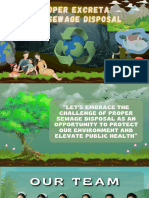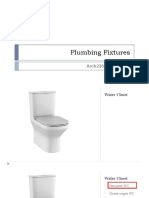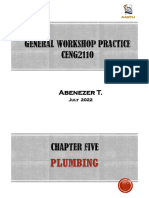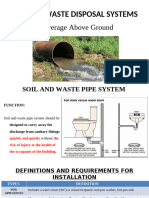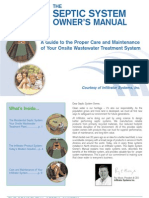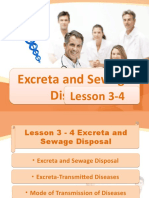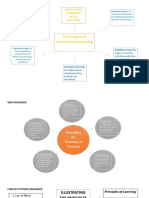0 ratings0% found this document useful (0 votes)
Sanitation: Nicolle Zharizze Ebale Taboclaon, RMT
Sanitation: Nicolle Zharizze Ebale Taboclaon, RMT
Uploaded by
vanessa patayonThe document discusses sanitation facilities and their definitions. It provides definitions for improved sanitation facilities such as flush toilets connected to sewer systems or septic tanks, and pit latrines with slabs, as well as unimproved facilities like bucket toilets, open defecation, or flush toilets of unknown connection. The document aims to classify sanitation access and understand where human waste is disposed of.
Copyright:
© All Rights Reserved
Available Formats
Download as PPTX, PDF, TXT or read online from Scribd
Download as pptx, pdf, or txt
Sanitation: Nicolle Zharizze Ebale Taboclaon, RMT
Sanitation: Nicolle Zharizze Ebale Taboclaon, RMT
Uploaded by
vanessa patayon0 ratings0% found this document useful (0 votes)
The document discusses sanitation facilities and their definitions. It provides definitions for improved sanitation facilities such as flush toilets connected to sewer systems or septic tanks, and pit latrines with slabs, as well as unimproved facilities like bucket toilets, open defecation, or flush toilets of unknown connection. The document aims to classify sanitation access and understand where human waste is disposed of.
Original Title
SANITATION.pptx
Copyright
© © All Rights Reserved
Available Formats
PPTX, PDF, TXT or read online from Scribd
Share this document
Did you find this document useful?
Is this content inappropriate?
The document discusses sanitation facilities and their definitions. It provides definitions for improved sanitation facilities such as flush toilets connected to sewer systems or septic tanks, and pit latrines with slabs, as well as unimproved facilities like bucket toilets, open defecation, or flush toilets of unknown connection. The document aims to classify sanitation access and understand where human waste is disposed of.
Copyright:
© All Rights Reserved
Available Formats
Download as PPTX, PDF, TXT or read online from Scribd
Download as pptx, pdf, or txt
0 ratings0% found this document useful (0 votes)
Sanitation: Nicolle Zharizze Ebale Taboclaon, RMT
Sanitation: Nicolle Zharizze Ebale Taboclaon, RMT
Uploaded by
vanessa patayonThe document discusses sanitation facilities and their definitions. It provides definitions for improved sanitation facilities such as flush toilets connected to sewer systems or septic tanks, and pit latrines with slabs, as well as unimproved facilities like bucket toilets, open defecation, or flush toilets of unknown connection. The document aims to classify sanitation access and understand where human waste is disposed of.
Copyright:
© All Rights Reserved
Available Formats
Download as PPTX, PDF, TXT or read online from Scribd
Download as pptx, pdf, or txt
You are on page 1/ 15
SANITATION
NICOLLE ZHARIZZE EBALE TABOCLAON,
RMT
Safe management of human excreta is vital for public
health and is widely recognized as a human right.
While access to a hygienic toilet facility is essential
for reducing the transmission of pathogens, it is
equally important to ensure safe disposal of the
excreta produced
What kind of toilet facility do members of
your household usually use?
Flush / pour flush Flush to piped sewer system
Flush to pit latrine
Flush to open drain
Flush to don’t know where
Dry pit latrines Pit latrine with slab.
Pit latrine without slab / Open pit
Composting toilets Twin pit with slab
Other composting toilet
Bucket
Hanging toilet / hanging latrine
No facility / Bush / Field
Others (specify)
Definitions of improved
sanitation facilities:
• Flush/pour-flush toilet: a flush • Flush to piped sewer system: is a
toilet has a cistern or holding tank to toilet that flushes excreta to a system
store water for flushing and has a of sewer pipes, also called sewerage,
water seal (which is a U-shaped pipe which is designed to collect human
below the seat or squatting pan) to excreta (faeces and urine) and
prevent the passage of flies and wastewater and remove them from the
odours. A pour-flush toilet also has a household environment.
water seal but has no cistern and
water is poured by hand for flushing.
• Flush to septic tank: is a toilet
that flushes excreta to a water-
tight container, normally buried
underground away from the
dwelling, designed to separate
liquids from solids which are
then allowed to settle and
decompose.
• Flush to pit latrine: is a toilet
that flushes excreta to a covered
pit which retains solids. The
base and sides of latrine pits
may be permeable to allow
liquids to percolate into the
soil.
• Pit latrine with slab: is a dry • Container based sanitation: refers to
sanitation system that collects excreta a system where toilets collect excreta
in a pit in the ground. The pit is directly in sealable, removable
covered by a squatting ‘slab’ or containers (also called cartridges)
platform that is constructed from which are regularly collected by
materials that are durable and easy to commercial service providers and
clean. The ‘slab’ has a small drop delivered to treatment.
hole, or is fitted with a seat, allowing
excreta to be deposited directly into
the pit.
• Composting toilet: is a dry toilet into which carbon-rich material
(vegetable wastes, straw, grass, sawdust, ash) is added to the
excreta and special conditions maintained to produce inoffensive
compost. A composting latrine may or may not have a urine
separation device.
Definitions of unimproved sanitation facilities:
• Flush/pour flush to don’t know where: indicates that the
household uses an improved sanitation facility, but does
not know whether it flushes to a sewer, septic tank or pit
latrine.
• Flush/pour flush to open drain: refers to households using
toilets that discharge into uncovered drains which do not
effectively contain excreta thereby exposing the community
to faecal pathogens.
• Pit latrine without slab/open pit: is a dry sanitation system
that uses a pit in the ground for excreta collection and does
not have a squatting slab, platform or seat. An open pit is a
rudimentary hole in the ground where excreta is collected.
• Bucket: refers to the use of a bucket or other container
for the retention of faeces (and sometimes urine and
anal cleaning material), which are periodically removed
for treatment, disposal, or use as fertilizer.
• Hanging toilet/hanging latrine: is a toilet built over the
sea, a river, or other body of water, into which excreta
drops directly.
• No facility/bush/field: includes defecation in the bush or field or
ditch; excreta deposited on the ground and covered with a layer of
earth (cat method); excreta wrapped and thrown into garbage; and
defecation into surface water (drainage channel, beach, river, stream
or sea).
Do you share this facility with others who
are not members of your household?
Where is this toilet facility located?
Has your (pit latrine or septic tank) ever
been emptied?
The last time it was emptied, where were
the contents emptied to?
Was it removed by a service provider?
You might also like
- g6 Compiled 3rd Periodical Test All Subjects (Mam Inkay Peralta)92% (13)g6 Compiled 3rd Periodical Test All Subjects (Mam Inkay Peralta)75 pages
- Rural Sanitation & Sanitary Latrine: Building Services 1No ratings yetRural Sanitation & Sanitary Latrine: Building Services 123 pages
- 1.2-Basic Environmental Engineering (SAC)No ratings yet1.2-Basic Environmental Engineering (SAC)59 pages
- Group 9 - Proper Excreta and Sewage Disposal - CHN ReportingNo ratings yetGroup 9 - Proper Excreta and Sewage Disposal - CHN Reporting26 pages
- Sewage Disposal Systems, Treatments and Recycling100% (1)Sewage Disposal Systems, Treatments and Recycling19 pages
- Sanitory Appliances and Drainage and Venting Systems of A Washroom100% (1)Sanitory Appliances and Drainage and Venting Systems of A Washroom44 pages
- Plumbing Fixtures & Appliances: Building Services 1No ratings yetPlumbing Fixtures & Appliances: Building Services 112 pages
- Waste Treatment and Disposal For Individual Household and Small Communities-2019100% (1)Waste Treatment and Disposal For Individual Household and Small Communities-201930 pages
- Sanitary Fittings and Sewere Appurtenances: By-Shubham Parth Khalida Sankrita Gaurisha100% (1)Sanitary Fittings and Sewere Appurtenances: By-Shubham Parth Khalida Sankrita Gaurisha36 pages
- Presentation 006 - The-Waste-and-Soil-Pipe-Report-Group-4No ratings yetPresentation 006 - The-Waste-and-Soil-Pipe-Report-Group-417 pages
- Week 11 - Topics For Reporting (20241007220600)No ratings yetWeek 11 - Topics For Reporting (20241007220600)52 pages
- Chap 2c Soil and Waste Disposal System (Sewerage Above Ground)-1No ratings yetChap 2c Soil and Waste Disposal System (Sewerage Above Ground)-113 pages
- HOSPITAL PLANT AND BUILDING SERVICES - PPTX 2No ratings yetHOSPITAL PLANT AND BUILDING SERVICES - PPTX 247 pages
- Presentation1 BSE-I (sanitation) Fittings (2)No ratings yetPresentation1 BSE-I (sanitation) Fittings (2)33 pages
- SWM 301 Presentation 1 Introduction To Wastewater Drainage ConstructionNo ratings yetSWM 301 Presentation 1 Introduction To Wastewater Drainage Construction26 pages
- Course Code: CE 1001 Course Title: Waste Water Engineering Credit Hours: 4No ratings yetCourse Code: CE 1001 Course Title: Waste Water Engineering Credit Hours: 424 pages
- Planning and Design of Low Cost SanitationNo ratings yetPlanning and Design of Low Cost Sanitation26 pages
- Population Pyramid Worksheets and AnswersNo ratings yetPopulation Pyramid Worksheets and Answers1 page
- Cause Agent Type of Agent MOT Signs and Symptoms Prevention and Control Treatment TuberculosisNo ratings yetCause Agent Type of Agent MOT Signs and Symptoms Prevention and Control Treatment Tuberculosis6 pages
- Biochemistry 202: Tutorials Are OptionalNo ratings yetBiochemistry 202: Tutorials Are Optional3 pages
- Five Stages of Instructional Planning: Categorial Graphic OrganizerNo ratings yetFive Stages of Instructional Planning: Categorial Graphic Organizer4 pages
- Prevalence of Iron Deficiency Anemia in Pregnant Women of District Mardan, PakistanNo ratings yetPrevalence of Iron Deficiency Anemia in Pregnant Women of District Mardan, Pakistan6 pages
- Comment: For The UN Convention On Articles/default - Shtml?a cbd-02No ratings yetComment: For The UN Convention On Articles/default - Shtml?a cbd-023 pages
- Teaching Consistent Hand Hygiene: How Can We Improve?: ReviewsNo ratings yetTeaching Consistent Hand Hygiene: How Can We Improve?: Reviews8 pages
- Prevalence of Anaemia in Pregnant Women of District Mardan: Original ArticleNo ratings yetPrevalence of Anaemia in Pregnant Women of District Mardan: Original Article5 pages
- Waste Management: Sathish Paulraj Gundupalli, Subrata Hait, Atul ThakurNo ratings yetWaste Management: Sathish Paulraj Gundupalli, Subrata Hait, Atul Thakur9 pages
- CPAD-CPADM-Heatless-Dryer-Manual1 - Dew Point Demand Control SystemNo ratings yetCPAD-CPADM-Heatless-Dryer-Manual1 - Dew Point Demand Control System24 pages
- Rwanda National Land Use and Development Master Plan - Appendix 3No ratings yetRwanda National Land Use and Development Master Plan - Appendix 378 pages
- Case Study 1 - Law of Demand in A City of GujaratNo ratings yetCase Study 1 - Law of Demand in A City of Gujarat1 page
- SDG NO. (11) Sustainable Cities and CommunitiesNo ratings yetSDG NO. (11) Sustainable Cities and Communities15 pages
- Guidelines For The Use of Plastic Waste in Rural Roads ConstructionNo ratings yetGuidelines For The Use of Plastic Waste in Rural Roads Construction5 pages
- Drainage Layout: Scale 1:100 Area: 370 MNo ratings yetDrainage Layout: Scale 1:100 Area: 370 M1 page
- Innovation With CFD: Solutions and EquipmentNo ratings yetInnovation With CFD: Solutions and Equipment16 pages
- g6 Compiled 3rd Periodical Test All Subjects (Mam Inkay Peralta)g6 Compiled 3rd Periodical Test All Subjects (Mam Inkay Peralta)
- Rural Sanitation & Sanitary Latrine: Building Services 1Rural Sanitation & Sanitary Latrine: Building Services 1
- Group 9 - Proper Excreta and Sewage Disposal - CHN ReportingGroup 9 - Proper Excreta and Sewage Disposal - CHN Reporting
- Sanitory Appliances and Drainage and Venting Systems of A WashroomSanitory Appliances and Drainage and Venting Systems of A Washroom
- Plumbing Fixtures & Appliances: Building Services 1Plumbing Fixtures & Appliances: Building Services 1
- Waste Treatment and Disposal For Individual Household and Small Communities-2019Waste Treatment and Disposal For Individual Household and Small Communities-2019
- Sanitary Fittings and Sewere Appurtenances: By-Shubham Parth Khalida Sankrita GaurishaSanitary Fittings and Sewere Appurtenances: By-Shubham Parth Khalida Sankrita Gaurisha
- Presentation 006 - The-Waste-and-Soil-Pipe-Report-Group-4Presentation 006 - The-Waste-and-Soil-Pipe-Report-Group-4
- Chap 2c Soil and Waste Disposal System (Sewerage Above Ground)-1Chap 2c Soil and Waste Disposal System (Sewerage Above Ground)-1
- SWM 301 Presentation 1 Introduction To Wastewater Drainage ConstructionSWM 301 Presentation 1 Introduction To Wastewater Drainage Construction
- Course Code: CE 1001 Course Title: Waste Water Engineering Credit Hours: 4Course Code: CE 1001 Course Title: Waste Water Engineering Credit Hours: 4
- What Do You Mean My House Has a Septic Tank?From EverandWhat Do You Mean My House Has a Septic Tank?
- Cause Agent Type of Agent MOT Signs and Symptoms Prevention and Control Treatment TuberculosisCause Agent Type of Agent MOT Signs and Symptoms Prevention and Control Treatment Tuberculosis
- Five Stages of Instructional Planning: Categorial Graphic OrganizerFive Stages of Instructional Planning: Categorial Graphic Organizer
- Prevalence of Iron Deficiency Anemia in Pregnant Women of District Mardan, PakistanPrevalence of Iron Deficiency Anemia in Pregnant Women of District Mardan, Pakistan
- Comment: For The UN Convention On Articles/default - Shtml?a cbd-02Comment: For The UN Convention On Articles/default - Shtml?a cbd-02
- Teaching Consistent Hand Hygiene: How Can We Improve?: ReviewsTeaching Consistent Hand Hygiene: How Can We Improve?: Reviews
- Prevalence of Anaemia in Pregnant Women of District Mardan: Original ArticlePrevalence of Anaemia in Pregnant Women of District Mardan: Original Article
- Waste Management: Sathish Paulraj Gundupalli, Subrata Hait, Atul ThakurWaste Management: Sathish Paulraj Gundupalli, Subrata Hait, Atul Thakur
- CPAD-CPADM-Heatless-Dryer-Manual1 - Dew Point Demand Control SystemCPAD-CPADM-Heatless-Dryer-Manual1 - Dew Point Demand Control System
- Rwanda National Land Use and Development Master Plan - Appendix 3Rwanda National Land Use and Development Master Plan - Appendix 3
- Guidelines For The Use of Plastic Waste in Rural Roads ConstructionGuidelines For The Use of Plastic Waste in Rural Roads Construction













